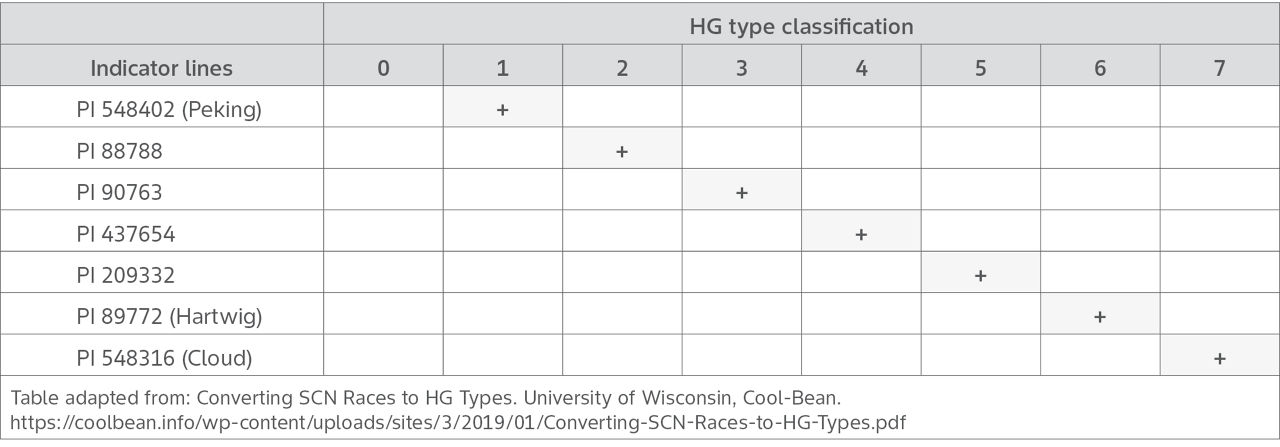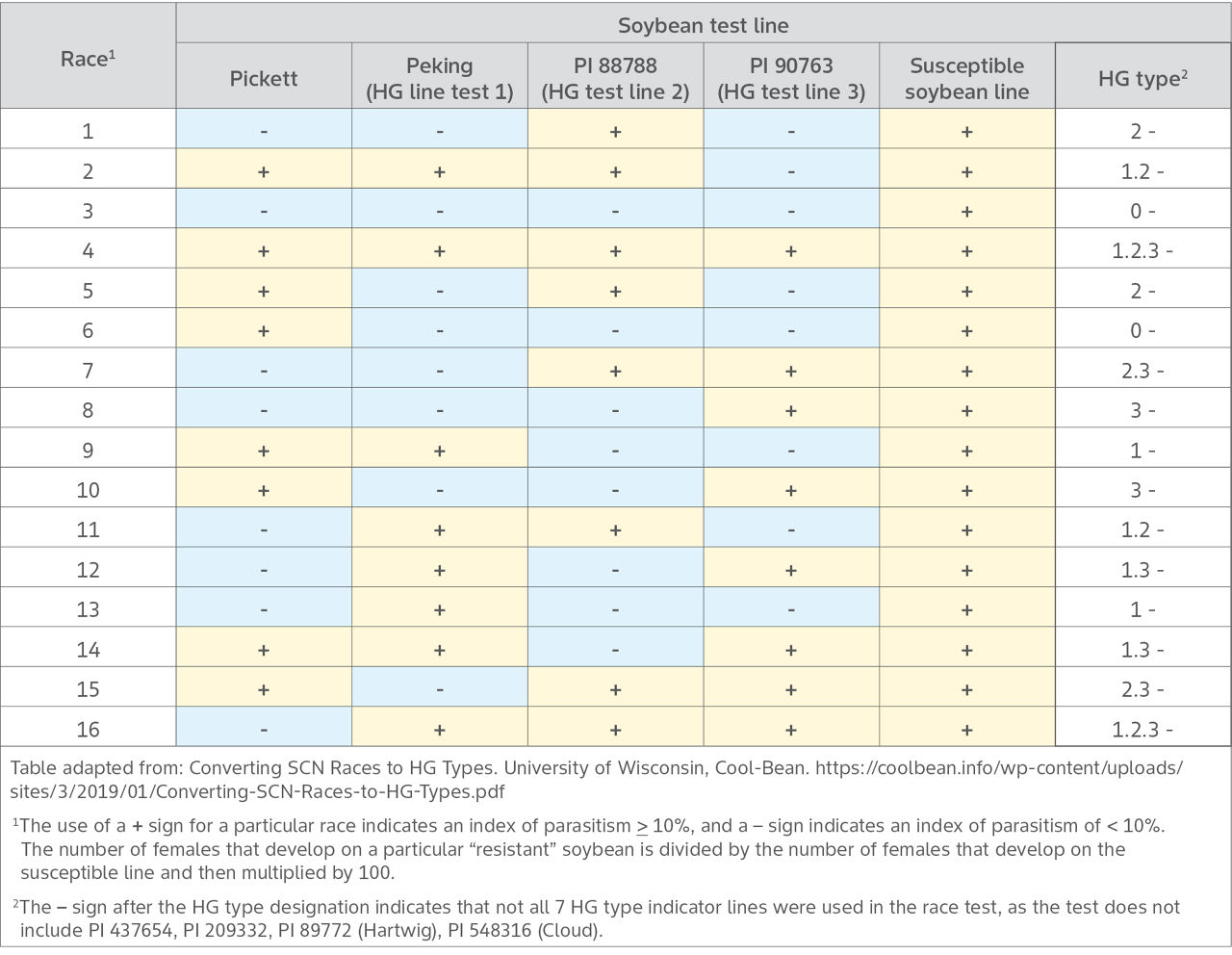Understanding Soybean Cyst Nematode Genetic Resistance
March 21, 2025
- The soybean cyst nematode (SCN; Heterodera glycines) is a significant pest of soybean in the U.S. and Canada and results in over a billion U.S. dollars in losses every year.
- First found in North Carolina in 1954, it has spread across the soybean production area in North America.
- By January 2020, SCN was detected in 30 states in the continental U.S., three Canadian provinces, and Puerto Rico.
The soybean cyst nematode (SCN) feeds and reproduces on soybean roots, injuring the plant by limiting water and nutrient uptake, which can increase soilborne infections by other pathogens. Aboveground symptoms of a SCN infection may not be observed until populations reach relatively high numbers; however, mature females can be identified on soybean roots by the naked eye. Aboveground symptoms appear as chlorosis of leaf tissue, plant stunting, and early senescence. Usually, damage appears in circular patches (foci) across the field in areas with lighter soil and particularly under dry soil conditions. Care should be taken when diagnosing problems based on aboveground symptoms alone as symptoms of SCN infection can be similar to those caused by other factors, such as nutrient deficiencies, soil compaction, and herbicide injury.
Races of Soybean Cyst Nematode and HG type test
Variability within SCN populations has been well known for many years, with SCN populations assigned to 16 different races (Table 2). The races are differentiated by the ability of SCN populations (not individuals) to reproduce on four standard soybean differentials (plants that express different genes for resistance to SCN). Race designations are assigned depending on the amount of reproduction that occurs on each soybean differential as compared to reproduction on a standard susceptible soybean line. The number of females that develop on a particular differential is divided by the number of females that develop on the susceptible line and multiplied by 100, giving a percentage, which is referred to as the index of parasitism (IP). Using the 10% rule, if the IP is less than 10%, the soybean is considered resistant and assigned a (–). More recently, a new test was developed and called the HG (Heterodera glycines) type test (Table 1). It continues to use the 10% rule, but the list of differentials has been updated to include all known differentials that have resistance. It is possible for a population to be composed of more than one HG type or race (ie. a population with greater than 10% reproduction on both Peking and PI 88788 would have the designation of an HG type 1.2). It is recommended that an HG type or race test be conducted every 10 years to confirm the HG type or race of the SCN population in each field.
Table 1. HG (Heterodera glycines) type test for populations of soybean cyst nematode.

Table 2. Soybean cyst nematode races in relation to HG type.

Resistance to the Resistance
After more than 40 years of relying on PI 88788 as the foundation of providing host resistance to SCN, populations have become resistant to soybean cultivars with that source of genetic resistance. About 90% of the current soybean germplasm rely on PI 88788. The incorporation of other resistant germplasm into breeding lines has become necessary to maintain the use of host plant resistance as a management option. The other source of resistance that is gradually becoming incorporated is PI 548402, also referred to as Peking, and to a lesser extent PI 89772 or Hartwig. There is evidence of SCN populations with the ability to overcome the Peking form of resistance as well, but it appears to not be as widespread as the resistance to PI 88788, as of now.
Management
Host resistance to SCN is not conferred by a single resistance gene, and soybean products developed from the same source of resistance do not necessarily provide the same level of resistance. That is why it is important to rotate products that are developed from the same source of resistance, as this is likely to result in rotation of the resistance genes as well. Rotating soybean varieties with varying sources of resistance will help promote the longevity of the resistance source and slow the break-down in effectiveness, as has happened with the PI 88788 form of resistance over time. Be sure to consult with your seed provider to understand which sources of resistance are available in the correct relative maturity to best meet the needs of your farming operation.
Other management tactics include:
- Crop rotation
- Rotate with a non-host crop like corn, small grains, cotton, grain sorghum, sugarbeet, and sunflower, which can help lower SCN population densities.
- Manage soybean volunteers and weeds
- Several weeds such as henbit, purple deadnettle, field pennycress, vetch species, and other legumes can sustain a SCN population.
- Manage soil movement
- Cysts and eggs in soil can be moved via water, equipment, and wind. Ensure that used or borrowed equipment is properly cleaned before it enters a new field.
- Seed treatments
- There are seed treatments available to provide protection against SCN, but these products should be used in a comprehensive management program and not as a single tool.
Sources
Bissonnette, K., Faske, T., and Tenuta, A. 2021. An overview of soybean cyst nematode. Crop Protection Network. https://cropprotectionnetwork.org/publications/an-overview-of-soybean-cyst-nematode.
Converting SCN Races to HG Types. University of Wisconsin, Cool-Bean. https://coolbean.info/wp-content/uploads/sites/3/2019/01/Converting-SCN-Races-to-HG-Types.pdf
1315_503251